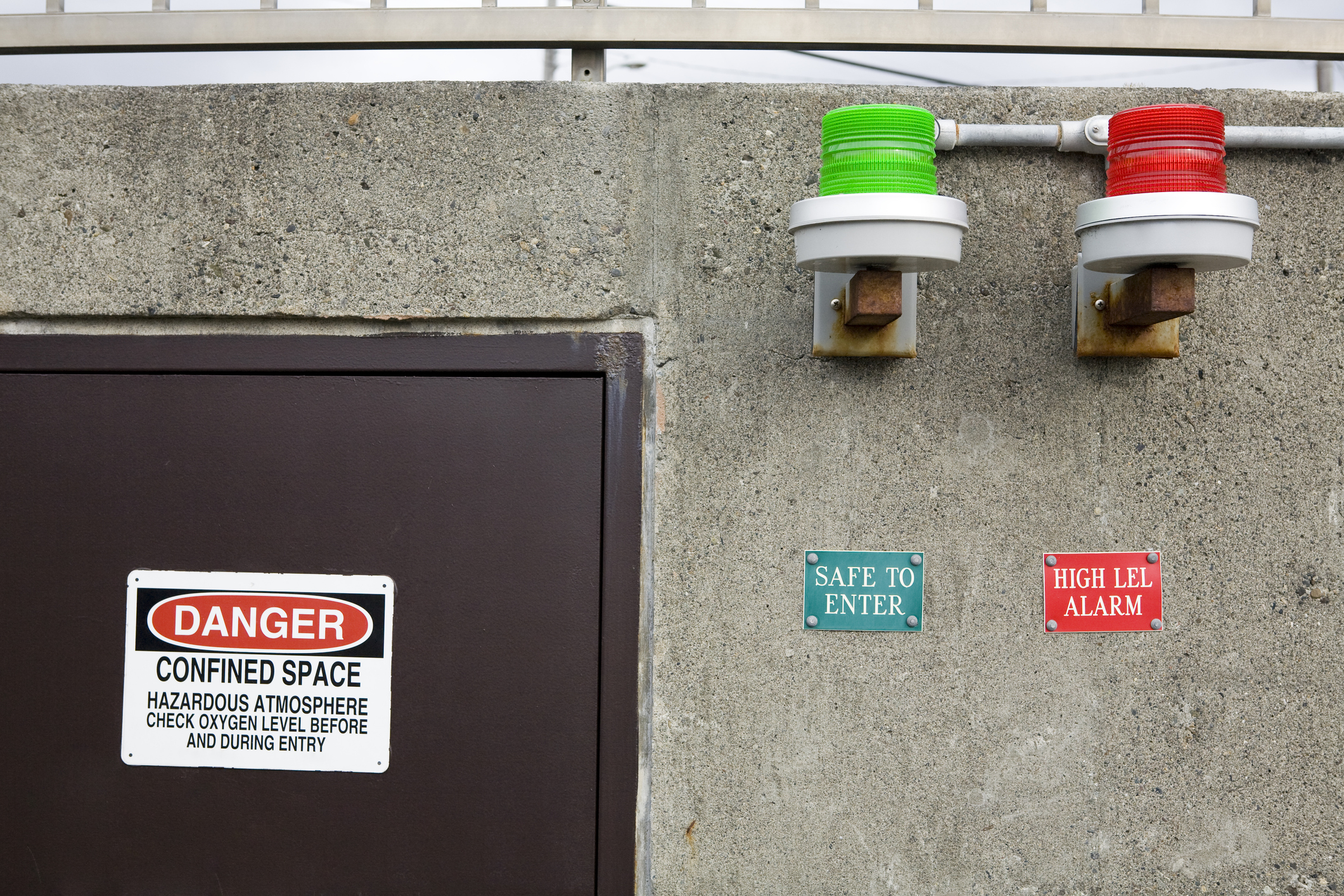Fredericksburg, VA
Creating Modern Solutions to Improve Safety Programs
Challenge
A confidential client in Virginia requested a thorough hazard assessment of confined spaces throughout the County operations. Specifically, these services will focus on modernizing the confined space program to accomplish the following objectives:
- Onsite auditing/assessments of multiple County locations to identify permit and non-permit confined spaces of approximately 150 locations to include, but not limited to the following:
- Solid waste landfill
- Solid waste convenience centers (13)
- Composting and ancillary equipment
- Wastewater treatment plants (3)
- Water treatment plants (2)
- Storage tanks
- Sewer pump and water booster stations
- Opportunities to remove the identified confined space by utilizing OSHA hierarchy of controls.
- A cloud based confined space entry solution that includes an auditing/assessment.
- Ability to order and install confined space labeling that is consistent across the County.

Solution
TRC conducted a confined space hazard assessment for over 400 spaces to evaluate the hazards that exist or potentially exist based on the use of the space, products or materials stored in the space, existing entry conditions, and/or access/egress issues.
The hazard assessment documented the following:
- Hazards by type:
- Potential atmospheric hazards
- Physical hazards
- Biologica
- Location by GIS coordinates, department, and facility.
- Safety equipment required for entry.
- Photograph of the space and signage.
The assessment determined if the space is considered a Permit or Non-Permit Confined Space. TRC collected the data by using TRC’s Mobile Data Solutions app, customized for the County operations.
Results
TRC was able to complete 412 confined space hazard assessments and provide detailed documentation of each space. The assessment allowed the County to upgrade the confined space inventory, revise their program and ensure proper signage for each space.
Sharing Our Perspectives
Our practitioners share their insights and perspectives on the trends and challenges shaping the market.

OSHA Enforces New National Emphasis Program to Address Concerns with Warehouses and Distribution Centers
August 23, 2023
Why is OSHA concerned with Warehouses and Distribution Center Operations? The warehousing and distribution centers industries are growing rapidly, with employment increasing from 668,900 workers in 2011 to 1,713,900 in 2021. Within these same industries, there have been high rates of illness and injury. Specifically, within the warehousing and storage industry, top illnesses and injuries in 2020 included:

Changes to EPA’s Risk Management Program (RMP) Regulations Are Coming
April 14, 2023
Changes to the Risk Management Program (RMP) regulations were signed into a final rule on February 27, 2024, by EPA Administrator Michael S. Regan.

Routinely Evaluating the Health & Effectiveness of Integrated Systems to Manage EHS/ESG Risks – Part I
March 1, 2023
Once established, an EHS/ESG management system must be routinely evaluated to ensure it remains effective to identify and control risks, as well as accommodate and adjust for changes that occur to/within the organization.

Optimizing EHS/ESG Information Management and Reporting Systems by Leveraging Innovative Digital Technology Solutions
August 10, 2022
A single, integrated enterprise wide EHS/ESG IMS can significantly improve performance and communicate progress towards organizational requirements and goals.

Support an Integrated EHS/ESG Management System
June 10, 2022
According to the National Safety Council (NSC), an employee is injured on the job every seven seconds. Workplace accidents are all too common and can cause major problems for employees and employers. We’re going to look at some of the most common workplace accidents and discuss how to avoid and prevent them so you and your employees can enjoy the benefits of a safe work environment.

How to Use an Integrated Approach To Manage EHS and ESG Risks
April 20, 2022
According to the National Safety Council (NSC), an employee is injured on the job every seven seconds. Workplace accidents are all too common and can cause major problems for employees and employers. We’re going to look at some of the most common workplace accidents and discuss how to avoid and prevent them so you and your employees can enjoy the benefits of a safe work environment.

OSHA Returns to In-Person Inspections As COVID-19 Restrictions Lift
August 4, 2021
The Occupational Safety and Health Administration (OSHA) is authorized by the Occupational Safety and Health Act of 1970 (OSH Act) to assure employers provide safe and healthful work conditions free of recognized hazards and by setting and enforcing standards and providing training, outreach, education and technical assistance. OSHA has recently announced the return to in-person inspections as COVID-19 restrictions begin to lift.

Managing EHS & ESG Risks Through Integrated Systems Today and Beyond
July 22, 2021
It has been more than 50 years since the development and establishment of the federal Environmental Protection Agency (EPA) and the federal Occupational Safety & Health Administration (OSHA) which were formed to protect our environment and workplaces across the United States. Significant laws, policies and regulations followed to establish the “regulatory programs” that all applicable businesses and entities must address and meet to ensure these compliance-driven legislative programs would create a foundation to protect our society.

TRC’s Reporting Tool Can Help Identify New PFAS under the TRI
May 19, 2020
While utilities often work in technical silos, NERC auditors are trained to cross check compliance evidence and data between interrelated standards.

EPA Unveils Largest Deregulatory Initiative in U.S. History
April 1, 2025
Environmental Protection Agency (EPA) Administrator Lee Zeldin has announced the Agency’s plan to undertake 31 deregulatory actions with the stated goal of driving down the cost of living for Americans and revitalizing the American energy and auto industry.

Fostering an Enjoyable and Resilient Project Management Career
March 10, 2025
In his final contribution to EM Magazine, TRC’s David Elam shares his thoughts on the health, well-being and success of project managers everywhere. These takeaways go beyond skills and habits in the workplace, and explore how project managers can align their lives outside of work with their professional goals.

Changes to EPA’s Risk Management Program (RMP) Regulations Are Coming
April 14, 2023
Changes to the Risk Management Program (RMP) regulations were signed into a final rule on February 27, 2024, by EPA Administrator Michael S. Regan.

Routinely Evaluating the Health & Effectiveness of Integrated Systems to Manage EHS/ESG Risks – Part I
March 1, 2023
Once established, an EHS/ESG management system must be routinely evaluated to ensure it remains effective to identify and control risks, as well as accommodate and adjust for changes that occur to/within the organization.

EPA Publishes Effluent Guidelines Program Plan 15
February 14, 2023
The EPA announced updated effluent limitations guidelines under Plan 15, focusing on the evaluation and rulemaking process for per- and polyfluoroalkyl substances (PFAS) discharges.

Proactive Enforcement is Key in the EPA FY2022-2026 Strategy
October 19, 2022
A core element of the EPA FY2022-2026 Strategic Plan focuses on environmental compliance.

Optimizing EHS/ESG Information Management and Reporting Systems by Leveraging Innovative Digital Technology Solutions
August 10, 2022
A single, integrated enterprise wide EHS/ESG IMS can significantly improve performance and communicate progress towards organizational requirements and goals.

Five New PFAS Added to EPA Regional Screening Levels (RSLs)
June 24, 2022
EPA announced the addition of five new PFAS to the list of Regional Screening Levels (RSLs)

Integrating Sustainability, Digital Connectivity and Design Optimization in Wastewater Treatment Systems
June 20, 2022
Some organizations rarely think about water and wastewater treatment, until there is a problem. American industry depends on the ability to treat wastewater discharges while complying with regulatory standards and addressing emerging contaminants. If wastewater treatment fails, our environment is negatively impacted, and companies are exposed to shutdowns, delays and fines.

Support an Integrated EHS/ESG Management System
June 10, 2022
What Is an Indoor Air Quality Assessment? An indoor air quality assessment involves identifying and addressing air quality issues within a facility to ensure a healthy and safe environment for occupants. The assessment process typically includes an initial inspection, laboratory testing for contaminants, and recommendations for improvements. LEED-certified buildings prioritize indoor air quality, adopting measures to maintain good IAQ throughout construction and occupancy. Contact Us

Worst Case Discharges of Hazardous Substances – Proposed Rule
May 25, 2022
In compliance with the Clean Water Act (CWA), the U.S. Environmental Protection Agency (EPA) recently proposed a new rule for onshore non-transportation-related facilities requiring specified facilities to plan for worst case discharges (WCDs) of CWA hazardous substances that could cause substantial harm to the environment.

PFAS Discharges and NPDES Permits
May 25, 2022
On April 28, 2022, the U.S. Environmental Protection Agency’s (EPA) Office of Water released a memo addressing the use of National Pollutant Discharge Elimination System (NPDES) permits to restrict per- and poly-fluoroalkyl substances (PFAS) discharges to water bodies.

How to Use an Integrated Approach To Manage EHS and ESG Risks
April 20, 2022
What Is an Indoor Air Quality Assessment? An indoor air quality assessment involves identifying and addressing air quality issues within a facility to ensure a healthy and safe environment for occupants. The assessment process typically includes an initial inspection, laboratory testing for contaminants, and recommendations for improvements. LEED-certified buildings prioritize indoor air quality, adopting measures to maintain good IAQ throughout construction and occupancy. Contact Us

SEC Releases New Proposed Rules Requiring Public Companies to Disclose Climate Risks
April 12, 2022
On March 21, 2022, the U.S. Securities and Exchange Commission (SEC) issued its proposed rules for The Enhancement and Standardization of Climate-Related Disclosures for Investors which would require public companies in the U.S. to disclose information in their annual financial reports.

PFOA & PFOS As CERCLA Hazardous Substances: What Does This Mean and How Can You Be Prepared?
February 17, 2022
A plan to designate two per- and polyfluoroalkyl substances (PFAS) as “hazardous substances” under CERCLA was recently submitted by the EPA.

EPA Adds First New Hazardous Air Pollutant Since 1990
January 14, 2022
EPA finalized a rule to add 1-bromopropane to the federal list of hazardous air pollutants (HAPs) on December 22, 2022.

EPA Finalizes TRI Reporting Requirements for Natural Gas Processing Facilities
December 7, 2021
EPA finalized rule to add natural gas extraction and/or processing plants to Toxics Release Inventory reporting requirements

OSHA’s National Emphasis Program on Heat-Related Illness and Injuries
November 3, 2021
On September 20, 2021 in an OSHA National News Release, OSHA published a memorandum establishing an enforcement initiative that is designed to prevent and protect employees from heat-related illnesses and death. This initiative, which develops a National Emphasis Program (NEP) on heat inspections, is an expansion of an already existing Regional Emphasis Program (REP) in OSHA’s Region VI, which covers Arkansas, Louisiana, New Mexico, Oklahoma and Texas.

NJDEP Implements New Jersey Environmental Justice Law Through Administrative Order
October 5, 2021
On September 22, 2021, the New Jersey Department of Environmental Protection (NJDEP) Commissioner announced the issuance of Administrative Order (AO) No. 2021-25 to implement New Jersey’s Environmental Justice (EJ) Law. This order is effective immediately, and applicants seeking to site new major source facilities, renew major source permits or expand existing facilities with major source permits (e.g., Title V air permits) in overburdened communities are affected. There are more than 4.5 million people that live within 331 municipalities that are overburdened communities in the state of New Jersey.

OSHA’s Call for Comments on Mechanical Power Press Standard Changes
September 30, 2021
OSHA has recently published a call for comment regarding mechanical power presses. The reason behind OSHA’s request is that the American National Standards Institute (ANSI) consensus standard for mechanical power presses has been updated numerous times since the implementation of OSHA’s standard.

OSHA Returns to In-Person Inspections As COVID-19 Restrictions Lift
August 4, 2021
The Occupational Safety and Health Administration (OSHA) is authorized by the Occupational Safety and Health Act of 1970 (OSH Act) to assure employers provide safe and healthful work conditions free of recognized hazards and by setting and enforcing standards and providing training, outreach, education and technical assistance. OSHA has recently announced the return to in-person inspections as COVID-19 restrictions begin to lift.

EPA Proposed PFAS Reporting Requirement
July 29, 2021
New proposed rule would require all manufacturers and importers to report any amount of PFAS onsite

Managing EHS & ESG Risks Through Integrated Systems Today and Beyond
July 22, 2021
It has been more than 50 years since the development and establishment of the federal Environmental Protection Agency (EPA) and the federal Occupational Safety & Health Administration (OSHA) which were formed to protect our environment and workplaces across the United States. Significant laws, policies and regulations followed to establish the “regulatory programs” that all applicable businesses and entities must address and meet to ensure these compliance-driven legislative programs would create a foundation to protect our society.

OSHA COVID-19 Guidance, Regulation and Enforcement to Protect Workers
April 13, 2021
The Occupational Safety and Health Administration (OSHA) has signaled their intent to provide more guidance, regulation and enforcement with respect to protecting workers from contracting COVID-19 at their place of work. Among the key developments:

2020: A Year to Remember or a Year to Forget?
December 20, 2020
Published in EM Magazine, December 2020, this article by TRC’s David Elam speaks to the importance of pausing to reassess the work challenges we’ve faced due to COVID-19 this year and our accomplishments despite the challenges, and how to prepare for the coming year, after one of the most difficult years in modern history.

TRC Companies Inc. Acquires 1Source Safety and Health
November 11, 2020
TRC Companies (“TRC”), a leading technology-driven provider of end-to-end engineering, consulting and construction management solutions, has acquired 1Source Safety and Health, a firm that provides management consulting services in areas such as indoor air quality, asbestos management, industrial hygiene and safety management systems.

TRC Awarded a Yahara WINS Grant
August 28, 2020
TRC was recently awarded a Yahara WINS grant to develop a pilot scale simple aeration method for removing phosphorous from the discharge of manure digesters. The grant application was developed and submitted by: Bob Stanforth, Alyssa Sellwood, Mike Ursin, Ted O’Connell, Ken Quinn, and John Rice, who are members of multiple TRC CORE teams.

Ecological Risk of PFAS from AFFF-Impacted Sites
June 30, 2020
The facts on evaluating exposure to wildlife

How to Implement ISO 45001 – 2018, Occupational Health and Safety Management System
April 1, 2020
In March 2018, ISO finalized its occupational health and safety (OH&S) management system standard ISO 45001-2018. For those companies certified under the former occupational health and safety management system standard OHSAS 18001, the clock is ticking if you are considering migrating to the new ISO standard and maintaining your current certification. Companies that have implemented OHSAS 18001 and are interested in maintaining certification have until March 2021 or about a year to implement the new standard or lose certification.

TRC Brings Environmental Services to Manchester with Second UK Office
March 5, 2020
In continuing to expand our presence in a key British market, TRC is opening our second UK office in Manchester, England

2020 New Year’s Safety Resolution? How About Construction Safety?
February 20, 2020
Safety isn’t all about tracking statistics. To make it work, you need to interact positively with people. TRC construction health and safety specialist Cody Gladstone explains how to gain credibility on the jobsite and get everyone home safe at the end of the day.























